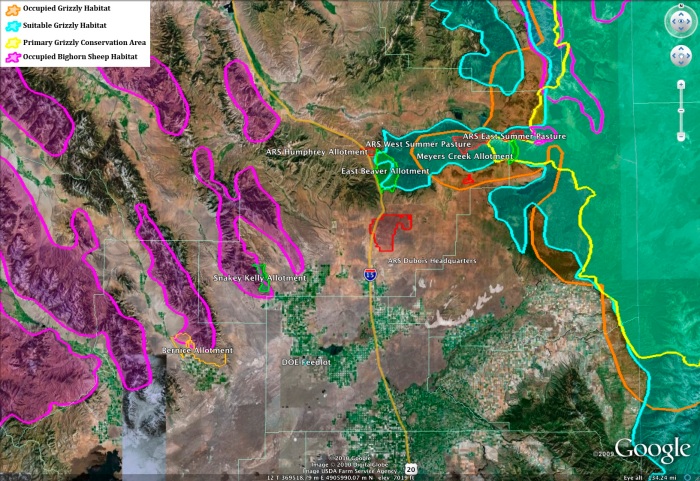Along Yellowstone’s western boundary, the Duck Creek, Cougar Creek and Madison River corridors are flowing with the migration of the country’s last wild buffalo. Buffalo families, solitary bulls, and bachelor bull groups beautifully ignore the ecologically meaningless man-made boundaries between Yellowstone and Montana as they spiral through this tiny fraction of their native homeland. As they gently graze the new spring grasses, they are taking a lead role in healing the wounded land that suffers in their absence. And in so doing, they also lift our spirits. Volunteers have been engaged in a total celebration of buffalo, and this week, we were gifted with the sightings of two newborn calves.
Patrols have also been blessed with the sightings of a grizzly bear, Sandhill cranes, white pelicans, otters, ospreys, bluebirds, great blue herons, bald eagles, moose, flickers, and many of the area’s animal inhabitants. This region, while sadly just a wee dot on the map, is huge in its wild majesty.
The buffalo’s spring migration has been keeping BFC quite busy along Highway 191, which cuts through the buffalo’s migration corridors. Patrols have been out at all hours, into the early morning darkness, warning traffic and helping buffalo (and motorists) survive this aspect of their journey. BFC’s night patrols are a huge boon to the buffalo and the community, and while it’s truly the responsibility of the State, Montana looks to BFC and we are honored to offer this service that has a direct and positive impact. BFC will continue to call on Montana to do more, including construct safe-passage projects that allow wildlife to cross the highway without setting foot on the asphalt.

Bull buffalo near Duck Creek. BFC file photo by Stephany.
For bull buffalo, the celebration has turned into a confusing nightmare. After molesting 8 bull buffalo along Yellowstone’s northern boundary, the USDA-Animal & Plant Health Inspection Service (APHIS) has arrived in West Yellowstone. Beginning yesterday on Horse Butte, APHIS drugged and collected semen from five bulls – some as young as two and a half years old like this young fella – in their “study” to determine what is already known: that bull buffalo pose no measurable risk of transmitting brucellosis to cattle. Under this extremely invasive study APHIS first darts the bulls to inject a drug to knock them out, then collects their semen by inserting a large vibrating probe in their anus. Before injecting the downed bulls with the reversal agent that wakes them, they spray-paint a thick blue line across their magnificent hind quarters. There will be no benefit for wild buffalo coming from this totally unnecessary and shameful study.
While BFC was documenting the first bull that went down, one of the APHIS technicians rudely and purposefully stepped in front of our camera multiple times, trying to prevent BFC from filming, causing a confrontation. He failed to stop us. Later in the day, patrols reported that APHIS agents were cracking jokes about the invasive work they were doing, making a mockery of how they were “handling” the bulls. In another instance, after APHIS darted a mature bull out of a bachelor group, one of the buffalo’s buddies got extremely upset and wanted to investigate what had happened to his friend, much like we witness during the buffalo hunt. He approached APHIS with his tail up, ready to charge and defend his comrade. APHIS responded by pepper-spraying the bull with bear-spray. A brief discussion with APHIS after they were done with their “data collection” yesterday revealed to us that the drugs they use on the bulls can cause them to overheat, disturb gastrointestinal functions, and cause anxiety and anger. They then monitor the bulls for a mere 30 minutes and then set their sights on another. The young bull who was targeted yesterday was so confused and visibly humiliated he left his family group and ended up walking through a near-by neighborhood on Horse Butte. We wonder if APHIS is warning Horse Butte residents that they are injecting bull bison with anger-inducing drugs?
Today, APHIS is again in our backyard, on the buffalo’s home turf. At the time of this writing, patrols report that no bulls have yet been molested by APHIS. They are being escorted around the area by a MT Department of Livestock agent, looking for “test subjects.” APHIS let us know that they will continue to target bull buffalo until the DOL gives them the heads up that hazing operations will begin. BFC will be with the buffalo, as we always are, ready to document all actions made against them, so we can share their story and turn the tide – with your help – towards a future where wild buffalo take precedence over the economic interests of the cattle industry. Together, we will realize our vision of self-willed buffalo walking the earth as they please, with honor and respect bestowed upon them and their sacred relationship to the Earth.
For the buffalo, for all things wild and free, celebrate Earth Day everyday!
ROAM FREE!


























